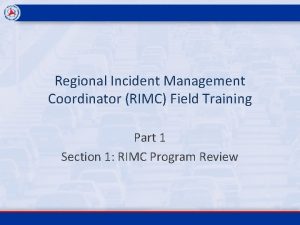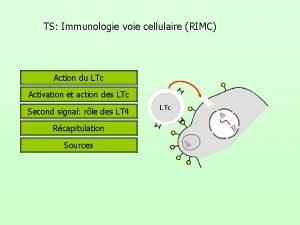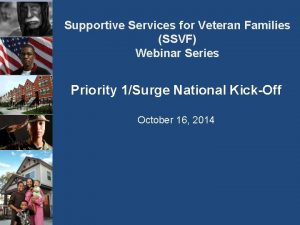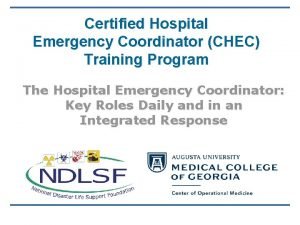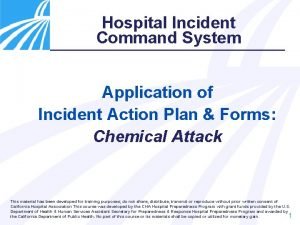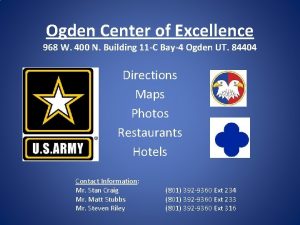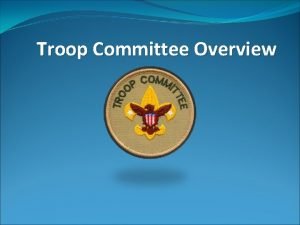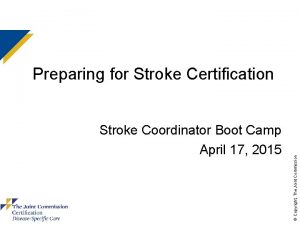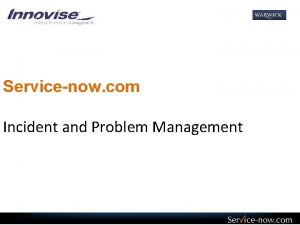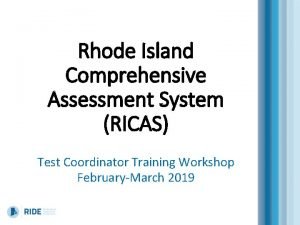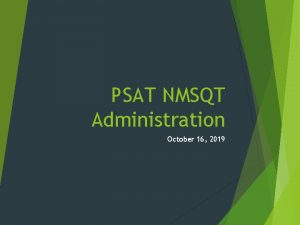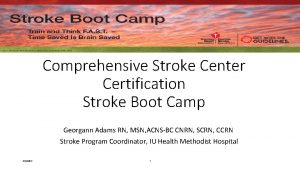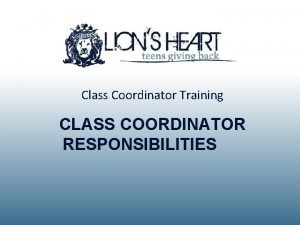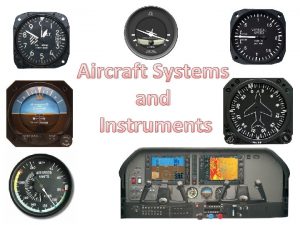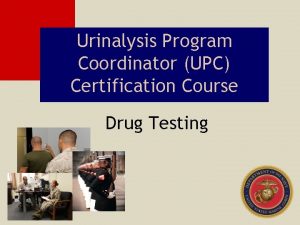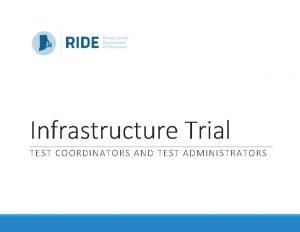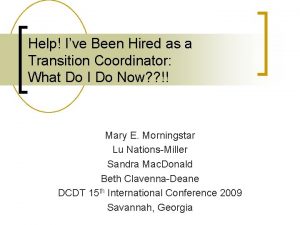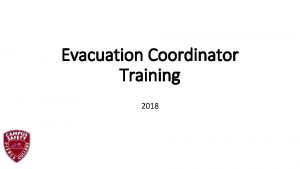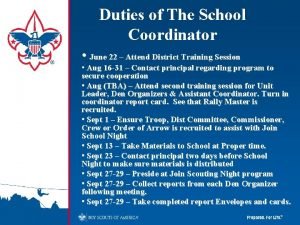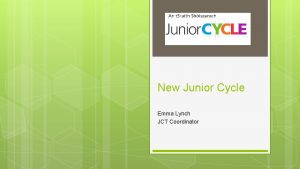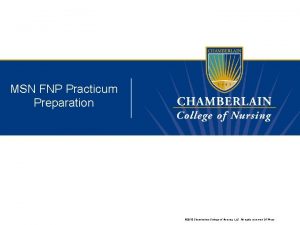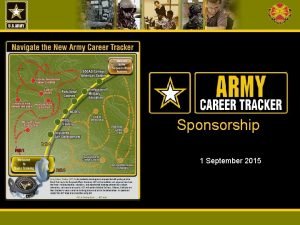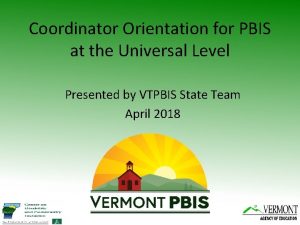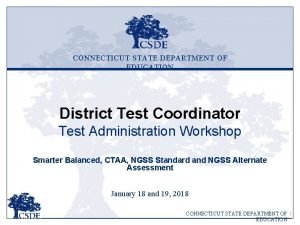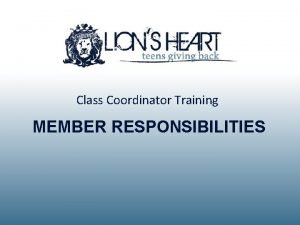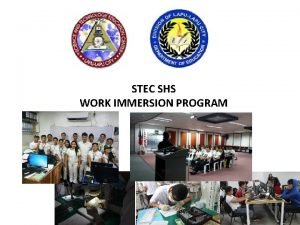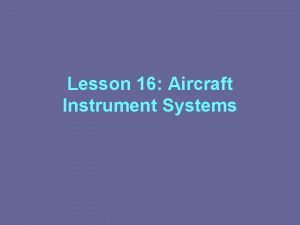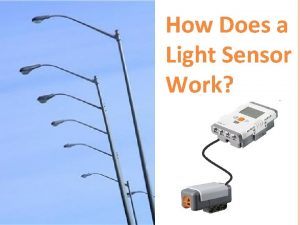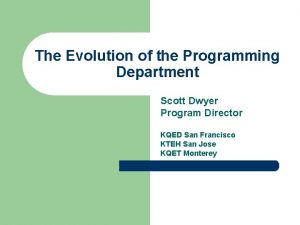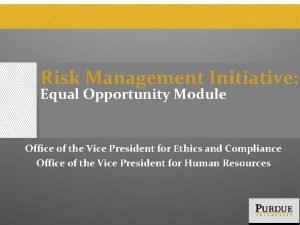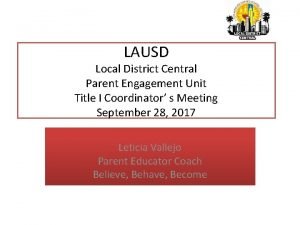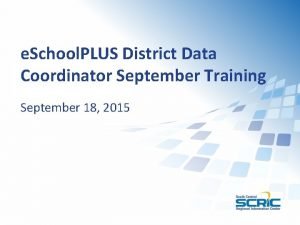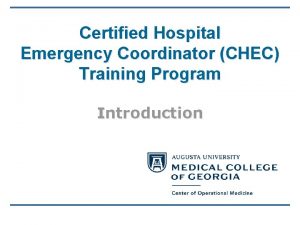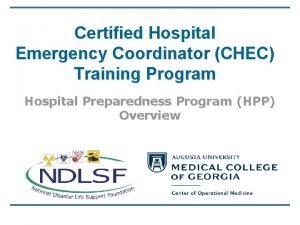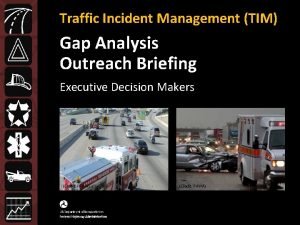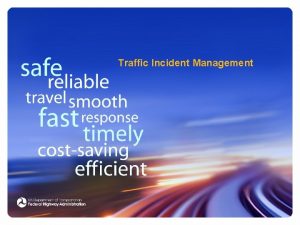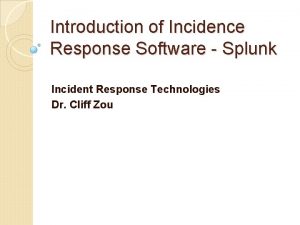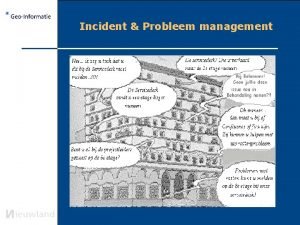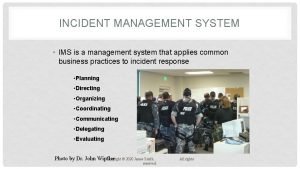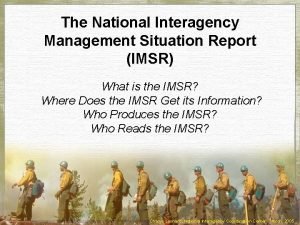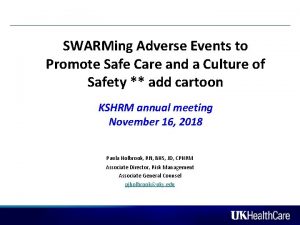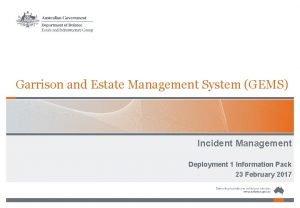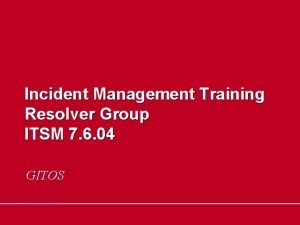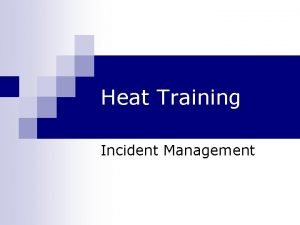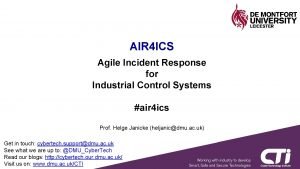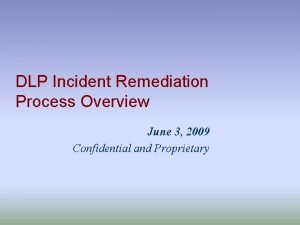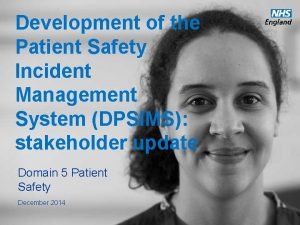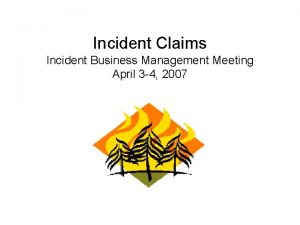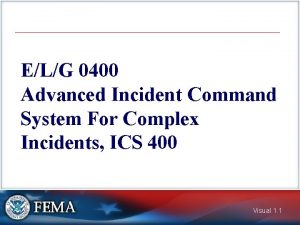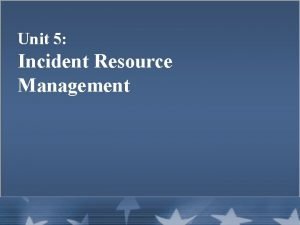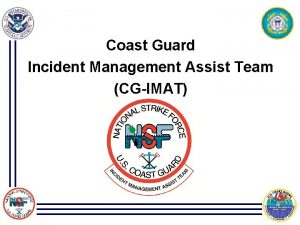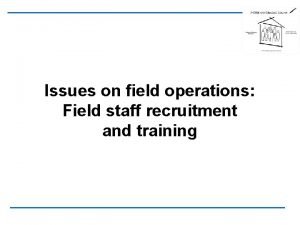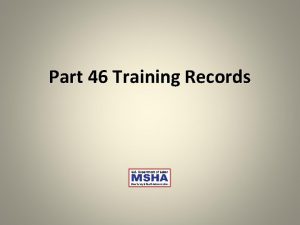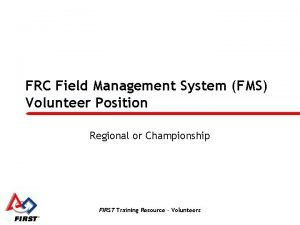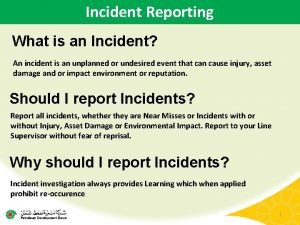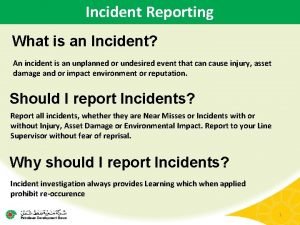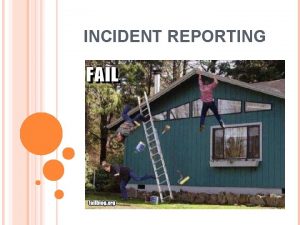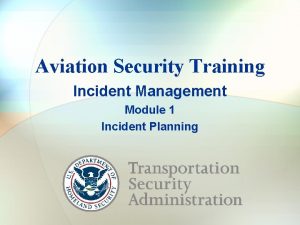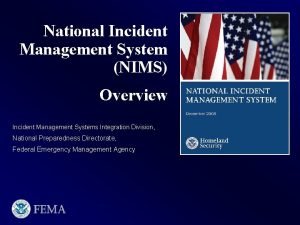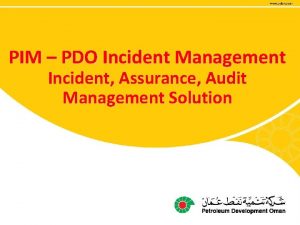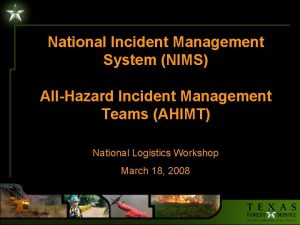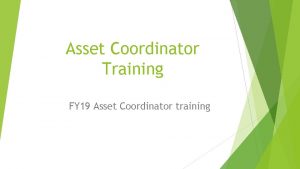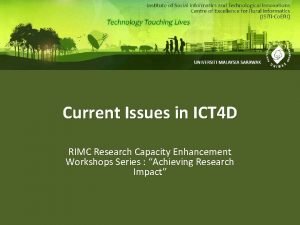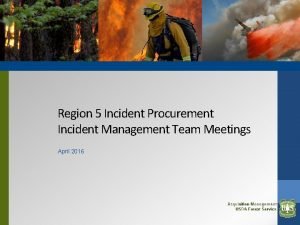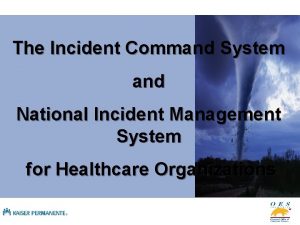Regional Incident Management Coordinator RIMC Field Training Part



































































































- Slides: 99

Regional Incident Management Coordinator (RIMC) Field Training Part 1 Section 1: RIMC Program Review

Learning Objectives At the conclusion of this training, the RIMC will gain practical application and exposure to: • Identifying the 4 key components of a RIMC response: § Evaluate/Assess § Respond/Coordinate § Communicate § Document • Understand the RIMC’s role in evaluating and sizing up different incident types and response strategies • Understand the importance of communication for situational awareness and verification of significant incident types • The importance of incident response documentation

Significant Incident Notification Process (SINP) History • Implemented May 2006 • Established single point of contact through 1800 number to the Statewide Traffic Operation Center • Ensures 24/7 service

Significant Incident Notification Process (SINP) Purpose: To provide law enforcement agencies and highway departments a mechanism for reporting: INFRASTRUCTURE PROBLEMS INCIDENTS ON STATE HIGHWAY NETWORK

Significant Incident Notification Process (SINP) SINP created the on-call Regional Incident Management Coordinator (RIMC) position to provide 24/7 response capabilities to incoming calls

Overview of RIMC Role RIMCs serve as Wis. DOT’s first responder and agency representative involving incidents on the state highway network, from beginning to end.

RIMC Scenario Matrix • Bridge Issues § Strike, Collapse, Lift Bridge • Miscellaneous Incidents § Fire/Smoke Over Roadway § Maintenance/Work Zone Incidents § Severe Traffic Backups (3 miles or more) • Responding to Incidents Caused by Weather Impacts § Flooding - Bridge Issue, Roadway Collapse or Washout, Water Over Roadway § Tornado, Straight-line Wind Damage • Roadway Damage/Incident § Crash § Culvert Failure § Pavement Buckling/Pavement Failure • Type I Signs § Guide Sign (Big Green) Specific Information Sign (SIS) – Knockdown or Damage

RIMC Response Expectations Evaluate/Assess • • Impacts to infrastructure Existing traffic control measures Incident duration Need for RDO notification - Significant Incident • Availability of county highway resources • Weather conditions

RIMC Response Expectations Respond/Coordinate • To provide DTSD response support to public safety first responders • Remain involved until the incident is completely resolved • Coordinate with Incident Commander (IC) traffic control strategies § TIMA, detours, lane closures, alternate routes • Coordinate with county highway department § Infrastructure repairs, flagging operations, clean up, traffic control equipment • Deploy Intelligent Transportation System (ITS) equipment § Portable Changeable Message Signs (PCMS), Closed Circuit TV (CCTV) • Coordinate contractor response and resources if needed Contractor

RIMC Response Expectations Communicate and Document • Communicate with the Incident Commander (IC) frequently throughout the incident • Communicate timely and accurate incident status/updates to RDO, TMC, DSP and others as needed • Monitor Traffic Incident Alerts (TIAs), public communications and other incident information • Provide public information as directed • Document incident response and all communications throughout the duration of the incident

Emergency Transportation Operations (ETO) Plan

What is Emergency Transportation Operations (ETO) Plan? 2016 Administrative Approved Terminology (ETO) Plan is a formal, coordinated, integrated and performance-oriented approach to managing transportation system resources during incidents and emergency events. Emergency transportation operations constitutes a continuum of efforts that are defined in Wis. DOT’s ETO Plan. The Plan provides a comprehensive framework of guidelines, procedures, and processes in support of incident response strategies to maintain a safe and efficient flow of traffic, preserve infrastructure integrity, facilitate communication and coordination and provide on-scene response support to public safety first responders and the traveling public during incidents and emergency events.

Emergency Transportation Operations (ETO) Plan • Under the ETO Plan: § Consists of the ETO Program § Consists of the Traffic Incident Management Enhancement (TIME) Program

Emergency Event Program History An emergency transportation operations program began in 2008 as an enhancement to Wis. DOT’s emergency response capabilities: • Proactive planning for emergencies and inclement weather • The program created three on-call positions: § Wis. DOT Highway Emergency Liaison Personnel (Wis. HELPer) § Statewide Bureau Duty Officer (SWBDO) – retired in March 2018 § Regional Duty Office (RDO)

Emergency Transportation Operations 1 5

What is the ETO program? Management of low frequency-high risk “emergency events” that impact our transportation system.

What is an Emergency Event? An Emergency Event is an escalated incident that disrupts the normal flow of traffic on the Interstate system or state highway network that requires an extreme response beyond normal daily operating procedures/capabilities or an event that disrupts normal operations/capabilities of a Wis. DOT business facility.

Emergency Event Examples • Traffic incident, e. g. crash, spill or major highway closure/blockage • Mass evacuation • Infrastructure-related incidents and failures • Natural disasters, e. g. severe weather event, tornado, flooding, fire, etc. • Facility or IT failure that disrupts operations and requires a response, potentially including activation of the Continuity of Operations Plan (COOP)

Emergency Event Examples (cont. ) • Potential threat to safety of Wis. DOT employees • Act of terrorism or violence against employees or the transportation infrastructure • Pandemic or other public health crisis • Event requiring multi-division, inter- regional or statewide Wis. DOT response • Event is anticipated to last longer than one operational period • An Incident commander requests Wis. DOT involvement

Emergency Event response is required when: • An exceptional event disrupts the normal flow of traffic on the Interstate system or state highway network • An extreme response is necessary beyond normal daily operating procedures/ capabilities OR • An event disrupts normal operations/capabilities of a Wis. DOT business facility

Emergency Event Activation Response • ICS based • Cross-divisional • Accountability through a continuous performance-based improvement process • Redundant communication procedures • Three general levels of Incident Command response: Local, Regional, Area/Statewide

Wisconsin’s Traffic Incident Management Enhancement (TIME) Program National TIM Responder Training

What is the TIME program? Management of high frequency-high risk “incidents” that impact our transportation system.

What is an Incident? “Any non-recurring incident that causes a reduction of roadway capacity or an abnormal increase in demand. "

Wisconsin TIME Program • What is TIME? - Comprehensive multi-agency, multi-discipline program enacted by Wis. DOT • What is the Purpose of TIME - Effectively and efficiently manage the response to traffic incidents to improve responder and motorist safety - Minimize traffic and community impacts

Traffic Incident Management Enhancement (TIME) Program • TIME meetings are intended to provide public safety and transportation partners a regular forum for discussing TIMrelated issues. • TIME meetings are conducted in each of the five Wis. DOT Regions to facilitate discussion, build relationships and promote a consistent program statewide. • Typical meeting topics TIME Program initiatives Special events/construction updates Incident debriefings Practical applications of Wis. DOT’s Emergency Traffic Control and Scene Management Guidelines: Good Practice or Lesson Learned § What’s new in Traffic Incident Management? § §

Overview: RDO/RIMC/Operational Supervisor Roles • RDOs serve as the on-call DTSD management point of contact for each region and supervise, advise and support the on-call RIMC - Regional Duty Officer position staffed by: Regional Directors and Section Chiefs • RIMCs serve as Wis. DOT’s initial responder and agency representative involving incidents on the state highway network, from beginning to end - RIMCs position is staffed by: maintenance, traffic and bridge personnel • Operational Supervisor provide backup and perform on-call duties on behalf of the RDO and review, debrief and approve the RIMC e. Logs

Regional Duty Officer (RDO) RDO’s Role and Responsibilities are: • To serve as the on-call DTSD management point of contact for each region • To supervise, advise and support the on-call RIMC

RDO Response Responsibilities • Serves as supervisory support, 24/7, for on-call RIMC – Must call RIMC back within 15 minutes • Serves as TMC communication backup for RIMC – When TMC can’t reach the on-call RIMC • Ensures Wis. DOT/DTSD response • Maintains situation awareness of incident • Provides required Administrator’s Office notification for Significant Incidents that meet trigger points • Authorizes and secures additional resources • Elevates an incident to a higher response level when warranted

RDO Responsibilities for Emergency Events • • Establish unified command with DSP Coordinate development of a Wis. DOT Event Plan (201) Facilitate planning and operational briefings Coordinate with the Emergency Event Program Manager to ensure an after-action review is conducted

Operations Supervisor Roles and Responsibilities • Provide backup and perform on-call RDO tasks on behalf of the RDO § During business hours § At times of critical need § Stay in communication with the on-call RDO to provide situational awareness • Review/debrief and approve the RIMC logs • Schedule RIMC rotational on-call duties § For regional offices § Managing schedule conflicts for on-call availability • Schedule and facilitate TIME After Action Reviews (AARs)

Operations Supervisor Expectations • Attend RIMC/RDO Basic Training, ICS and other required training • Attend Monday morning teleconferences with TMC and DSP § Designee may be assigned • Review and approve RIMC E-Log or paper log with the RIMC in a timely manner § Review should take place in the beginning of the week following the RIMC log submission

Roles of Other Responders • Incident Commander § Person in overall charge of an incident § May be the first person on scene § Usually law enforcement or fire • County Highway Department § Traffic control setup and traffic control device deployment - Highway closure authority § Plowing efforts § Flagging § Incident clean up and maintenance § Infrastructure repair • Law Enforcement § § § Life safety and scene stabilization Evidence preservation Crash reconstruction Hazmat (DNR warden) Initial traffic control setup - Highway closure authority • Fire and Rescue § Life safety and scene stabilization § Preservation of property § Emergency rescue response - Extrication § Hazmat response § Evacuation

Regional Incident Management Coordinator (RIMC) Field Training Part 1 Section 2: Regional Structure and Tools

Regional RIMC Teams • Each of the (8) Wis. DOT regional offices has its own RIMC Team • Each regional office has a RIMC on-call 24/7 NC Region Rhinelander Wisconsin Rapids NW Region Superior Eau Claire NE Region Green Bay SW Region La Crosse Madison SE Region Waukesha

Regional RIMC Teams • RIMCs serve on-call for one full week on a rotational basis • Frequency of on-call rotation varies by region • DTSD Standby and on-call policies apply: § *http: //dotnet/dtsd/policies/standby. htm

Team Structure and Schedule Protocols Team Structure Schedule Protocols • Regional RIMC teams may consist of staff from different sections of the Operations Units: • Frequency of rotation § Bridge § Maintenance/roadway § Traffic • Schedule changes • Updating schedule on ETO repository • Time off Rotational Hand-off Protocol • When/where do you hand-off RIMC communication equipment and resources • The time that hand-off is expected

Resource Recommendations: RIMC Vehicle

Resource Recommendations: RIMC Bag

Electronic Resources RIMC approved Wis. DOT devices • Refer to the Wis. DOT IT Policy and Procedures § Transportation Administration Manual (TAM 112) § http: //dotnet/tam/docs/it 101. docx • New apps or software require supervisor approval • All i. Pad activity is monitored and geo-located

RIMC Phone Functions & Use • Basic protocols § Lock, password § E-mail § Texting § Pictures § Downloading

Contacts and Resources Recommended Contacts Region Contacts • E-mail addresses § State § Regional § Local • Phone Numbers § State Technical Support Available § Regional • DOT Help Desk – 800 -362 -3050 • Hours of operation: 6: 00 AM to 5: 30 PM, Mon – Fri • On-call 24/7 with a voice mail

i. Pad Internet Access Virtual Private Network (VPN) • Works on Wis. DOT VPN Client installed equipment anywhere you have Internet, cellular signal or Wi-Fi Hotspot • A secure ID and PIN number are required for access • If you don’t use your VPN within 6 months it is locked out DOT Mobile § No more hard tokens, but now a soft token on the desktop § Used to connect to AD network and the internet § DOT Mobile will only work in range of DOT offices

RIMC Rotational Hand-Off Reminders • Receiving: § Make sure phone/i. Pad passwords match § Log-on once with VPN after i. Pad is handed off to you to ensure properation • Hand-off: § Make sure equipment is charged and ready for next RIMC § Clear emails and texts before handing off phone and i. Pad

Regional Incident Management Coordinator (RIMC) Field Training Part 1 Section 3: RIMC Incident Response

( SINP Call-Out ( TMC operators use the SINP incident notification and contact matrix to properly handle a wide range of calls: • There are 2 incident priority responses: § Immediate Priority § Next Day priority • An Immediate Priority Call, depending on category and type, will require a call out: § RIMC § Electrician § County Maintenance

( ( Initial RIMC Call-Out Initial call from TMC to RIMC phone Incident Occurs TMC is notified TMC Calls RIMC chooses direct answer vs. voice mail • Be prepared to copy provided information • Ask for information if you don’t receive it

( TMC Initial Preliminary Information ( TMC operators try to provide the RIMC with the following information on the initial call-out: • SINS number • Incident location and quick synopsis of incident • Road closure and direction • Alternate route if known • Caller and call-back number/handling agency Remember the TMC phone line is recorded! The control room operators are a part of our entire team. Courtesy should go both ways!

( Establishing On-Scene Contact • Your first point of contact may be a dispatcher § Identify yourself § Ask for additional information § Ask for the on-scene contact information • The on-scene contact may vary § Law enforcement, incident commander, county highway department, DNR, etc.

( On-Scene Contact: Special Note ( There will be times when the initial caller/agency will not provide you an on-scene number, if this occurs, you should request the initial caller/agency: • Have the on-scene contact call the RIMC back • Patch you through to the on-scene contact

( On-Scene Contact Communication • Get as much information as possible to evaluate and assess: ( • Why is this important? § Provide situational awareness § Anticipated incident duration § Wis. DOT DTSD resource management (County Highway Department) § Traffic impacts for traffic control strategy § Mitigate traffic impacts and queues § Incident scope and severity § Infrastructure damage

( Contacting County Highway Department ( • Contacting county highway department on-call personnel § Sheriff’s departments usually have access to this information § You can ask the Sheriff’s department dispatch to have the county highway department contact you § Remember to document your information for the RIMC log

( RDO Notification for Significant Incidents ( The RIMC is required to contact the RDO for any incident that meets the criteria of a significant incident Significant Incident

Significant Incident Criteria for RDO Notification

Three Ways To Respond Field Home Office

RIMC Response Expectations RIMC guidance on how to respond to an incident

Field Response Expectations Pre-Arrival • Drive and review the traffic control and/or alternate route before on-scene arrival • Be prepared to offer the on-scene contact: § Suggestions for a revised alternate route § Traffic control set up improvements

Field Response Expectations Cont. Scene Arrival • Always respond with proper identification • Report to on-scene contact or Incident Command (IC) • Meet at established location • Ensure you are arriving close to estimated time of arrival (ETA) • Advise the TMC when you are on scene

Field Response Expectations Cont. On-scene Incident Assessment: • Complexity of the incident • Infrastructure integrity and damage • Status of those involved in the incident • Scene stability • Estimated duration of incident • Hazardous materials?

Field Response Expectations Cont. Communicate and Document • The RIMC will contact and update the TMC and RDO • Document information to the RIMC log and timeline § Incident pictures and videos

Home and Office Response Expectations When a field response is not warranted or practical on a call from the TMC, response shall still take place from either the office or home You are still expected to perform the 4 key response components as if you were actually at the scene: Evaluate/Assess Respond/Coordinate Communicate Document

Home Response Example e. Log Discussion • e. Log #24536 • Disabled semi on shoulder

Home and Office Response Expectations Cont. Key points when responding from office or home • Establish on-scene contacts • RIMC needs to be in communication more often with on-scene contacts to confirm incident status and situational awareness of what is happening at the scene § Coordination is mostly done through phone calls § During business hours, the RIMC may ask personnel who are close to the scene to respond as the on-scene contact • Throughout the incident, the RIMC needs to frequently re-evaluate and assess: § Is the incident escalating? § Has a field response become warranted?

Home and Office Response Reminders • Maintain frequent communications with on-scene contact, TMC, RDO • Confirm incident status and situational awareness with on-scene contact • Monitor TIAs for accuracy • Confirm with on-scene contact that the roadway is checked before reopening • Stay involved in incident management until the incident is cleared § Advise TMC incident is cleared • Continuously document information to the RIMC log and timeline § Complete the RIMC log and timeline within the next business day

TMC Communication Update Reminder Provide incident status update to TMC and/or RDO

Regional Incident Management Coordinator (RIMC) Field Training Part 1 Section 4: Incident Response Scenarios

Incident Scenario 1 Bridge Issue

RIMC Incident Scenario: Bridge Issue A pick up truck, traveling at a high rate of speed, travels up embankment, becomes airborne, and strikes the bridge girder. The vehicle lands on its roof in lane 1 and blocks both NB lanes of traffic. Evaluate/Assess • What information should the RIMC evaluate to assess this incident once he/she is called? • Consult the RIMC Scenario Matrix § Bridge Issue

RIMC Scenario Matrix: Bridge Issue Evaluate/Assess • Infrastructure damage, i. e. railing, girders, abutment, piers, etc. § Bridge Engineer/Inspector assistance shall be required • Traffic impacts for queuing and delay, upstream and downstream § Location of on/off ramps and crossovers for traffic control § Trapped vehicles • Anticipated duration of incident with law enforcement or Incident Commander • Time of day, peak travel time and/or special events in the area • Estimated time to dissipate queue • Traffic control setup • If incident requires RDO notification of a Significant Incident • Utilize CCTV for monitoring purposes • Continuous incident monitoring (escalation/de-escalation of incident)

RIMC Scenario Matrix: Bridge Issue Detour • Possible long term detour may be needed if temporary repairs can’t be made or damage is too severe • Review, set up and travel detour route, if necessary, to accommodate traffic § Emergency alternate route guides may be invoked

RIMC Incident Scenario: Bridge Issue Respond/Coordinate • What steps will be involved in responding to this incident? • What are coordination considerations for this incident?

RIMC Scenario Matrix: Bridge Issue Respond/Coordinate • Field response will be required • Coordinate and set up lane closure • Coordinate with county highway department: § For traffic control strategies § To relieve law enforcement from flagging duties if possible • Utilize DMS/PCMS and ramp gates if available and needed

RIMC Incident Scenario: Bridge Issue Communicate • Continual communication efforts shall be required throughout the incident • RIMC communicating with: TMC • TIA • 511 • Floodgate DTSD External Agencies • RDO • Bridge Engineer/ Inspector • Maintenance • First responders • County highway department • DNR and others

RIMC Scenario Matrix: Bridge Issue Communicate • With the RDO if a Significant Incident Notification is warranted • Provide frequent and timely situational awareness updates to TMC as scene changes § Provide updates and confirm accuracy with TMC for 511, TIA and floodgate information • With Bridge Engineer/Inspector § Advise on closure of bridge and/or adjacent roadways § Consult on reopening bridge/roadway • In the event of a bridge structure emergency requiring central office notification or involvement § Structure expert on-call: (608) 206 -1280 § http: //dotnet/dtsd/emergency/index. htm

Wis. DOT Bridge Structure Emergency • Currently there is no statewide policy on bridge structure emergencies • RIMCS should contact their RDO • RIMCs should contact Bureau Of Structures (BOS) follow on bridge hits Reminder: • A Structure Expert from central office is on-call 24/7 and available to answer questions related to bridge structure emergencies: § Structure Expert on-call: (608) 206 -1280 § http: //dotnet/dtsd/emergency/index. htm • The Structure Expert does not respond to the scene when a bridge strike occurs • When a bridge hit occurs and is reported to the TMC, the TMC sends an email to: DOT DL BOS Bridge Hits, where BOS staff is notified

RIMC Incident Scenario: Bridge Issue Document • What type of information should the RIMC be documenting? • Where can the RIMC obtain information for documenting?

RIMC Scenario Matrix: Bridge Issue Document • Maintain RIMC response log • Take photos to document incident as it occurs to provide situational awareness, forward to RDO, Bridge Engineer and RCM if possible • Obtain law enforcement CAD number from incident report to assist with repair reimbursement

Incident Scenario 2 Work Zone Incident

RIMC Incident Scenario: Work Zone Incident A vehicle crash in the northbound lanes of I-94 hit the temporary work zone median barrier and moved it into the southbound lanes. The temporary median barrier needs to be moved back into place. Evaluate/Assess • Initial call to TMC • Work Zone Incidents § RIMC may/may not respond to the scene depending on incident scope and time of day - Work zone traffic control impacts to devices - Severe traffic backups - Crashes - Temporary roadways

RIMC Incident Scenario: Work Zone Incident Evaluate/Assess RIMC Call What assessment information does the RIMC need to respond to the call?

Protocol for Project Related Incidents When the TMC contacts the RIMC regarding project work zone related incidents: During Work Hours After Work Hours • Contact project leader, if no answer • Contact operations supervisor, if no answer • Contact the RDO • Traffic control devices: § Contact the emergency 24 -hour traffic control contact • Other project issue not related to traffic control devices § Contact prime contractor, if no answer § Contact project leader, if no answer § Contact the RDO The county highway department may need to be utilized for emergency situations where the contractor doesn’t answer their phone or if they are unable to resolve the situation in a timely manner.

RIMC Scenario Matrix: Work Zone Incident Evaluate/Assess • If incident meets criteria for RDO notification of a Significant Incident • Traffic control setup • Information from Incident Command, DSP, contractor, county highway department or other source: § Anticipated duration of incident § If this is a hazmat incident § Is there infrastructure damage or utility damage (i. e. downed power line) • Time of day, peak travel time and/or special events in the area • Traffic impacts for queuing and delay, upstream and downstream § Evaluate closing on-ramps and crossovers § Trapped vehicles • Estimated time to dissipate queue • CCTV to monitor situation • Continually monitor incident from beginning to end

RIMC Scenario Matrix: Work Zone Incident Detour • Review, set up and travel detour route, if necessary, to accommodate appropriate traffic § Emergency alternate route guides may be invoked

RIMC Incident Scenario: Work Zone Incident County Dispatch Call Respond/Coordinate • Field Response • Office Response • Home Response

RIMC Scenario Matrix: Work Zone Incident Respond/Coordinate • Field response probable • When traffic control assistance is necessary, call emergency contractor or project manager • RIMC may need to coordinate with RDO for communication efforts with contractor § If emergency contractor and project manager are unavailable, contact RDO § When in doubt, call the RDO • With RDO approval and as a last resort, coordinate traffic control strategies with county highway department • Set up lane or shoulder closures • Utilize DMS/PCMS and ramp gates if available and needed

RIMC Incident Scenario: Work Zone Incident Communicate

RIMC Incident Scenario: Work Zone Incident Document • Maintain RIMC response log • Take photos or video if field response is warranted • Document incident as it occurs to provide situational awareness • Forward to construction staff, RDO and RCM if possible • Note: Timeline is vital in documentation for project construction files

Incident Scenario 3 Severe Traffic Backups 3 Miles or More

RIMC Incident Scenario: Severe Traffic Backups Traffic delays of approximately 4 miles occurred due to a crash, which resulted in eastbound lane closures TMC Video

RIMC Scenario Matrix: Severe Traffic Backups Evaluate/Assess • If incident meets criteria for RDO notification of a Significant Incident § Criteria for notification of RIMC is 3 miles of backup • Verify/determine the cause of the backup so steps can be taken to eradicate it • Time of day, peak travel time and/or special events in the area • Traffic impacts for queuing and delay, upstream and downstream § Evaluate closing on ramps and crossovers § Trapped vehicles • Estimated time to dissipate queue • Traffic control setup • Continually monitor incident from beginning to end

RIMC Incident Scenario Matrix: Severe Traffic Backup Respond/Coordinate • Full closure impacts § Flight for Life (FFL) (Emergency helicopter) § Reconstruction • Impacts to on/off ramps, crossovers and ancillary roads • Traffic backups can escalate quickly and dissipate slowly

Rule of Thumb Impacts – Congestion and Delay • Non-recurring traffic incidents account for one-fourth of congestion and delay Special Events/ Poor Signal Other (5%) Timing (5%) • 1 minute of Interstate lane blockage Bad Weather translates into at least 4 minutes of (15%) delay • Secondary incidents (crashes) • Decreased quality of life Bottlenecks (40%) Work Zones (10%) • Poor public image of “us” • Economic impacts § Freight § Public Traffic Incidents (25%)

RIMC Scenario Matrix: Severe Traffic Backups Respond/Coordinate • Field, home or office response will be dependent on incident scope § Reassess response throughout incident § During business hours, RIMC may ask Wis. DOT personnel who are closer to the scene to respond and operate as the on-scene contact § When in doubt, go out! • May be working with contractors or traffic control sub-contractors • Determine traffic control actions based on cause, scale and estimated duration of backups • Coordinate traffic control strategies with county highway department • Utilize DMS, PCMS, ramp gates and advanced notice signs if available and needed • Note: This incident is adjacent to a construction zone

RIMC Incident Scenario: Severe Traffic Backups Communicate • Communicate with TMC frequently and in a timely manner • RDO triggers § Road closed in both directions for 30 minutes or more

RIMC Incident Scenario: Severe Traffic Backups Document: • e. Log • Paper log • Photos • Video

RIMC Incident Response Scenarios Summary • 4 Key components: § Evaluate/Assess § Respond/Coordinate § Communicate § Document • RIMC’s play an important role in evaluating and sizing up different incident types to determine response strategies • Communication is: § Key to a successful traffic incident management response § Continual throughout an incident and provides situational awareness § Verification of significant incident types • Documentation needs to be detailed to: § Improve response practices and protocols § Provide best practices/lessons learned for on-going training

Regional Incident Management Coordinator (RIMC) Field Training Part 2 Regional RIMC Mentoring Process

Regional RIMC Mentoring Process • Region selects a method(s) to carry out the task of mentoring and supporting new RIMCs § Region to place experienced RIMC on-call with new RIMC for first oncall rotational period. Experienced RIMC will respond to all calls with the new RIMC for that rotational period. § New RIMC will shadow (during working hours) any of the other experienced RIMC team members when they are on-call. The new RIMC will respond accordingly to incidents with them § Dedicate an experienced RIMC team member to assist the new RIMC when they are on their first on-call rotation. (Day and night) the new RIMC can call the dedicated experienced RIMC for assistance and guidance.

Next Steps • Trainers need to train the existing RIMCs, new RIMCs and Operational Supervisors • All future RIMCs will need to be trained using this training tool Questions? Thank you!
 Incident management coordinator
Incident management coordinator Ltc immunologie
Ltc immunologie Rimc et rimh
Rimc et rimh Ssvf university webinars
Ssvf university webinars Chec hospital
Chec hospital Incident objectives that drive incident operations
Incident objectives that drive incident operations Wmo regional training centres
Wmo regional training centres Tasfaa regional training
Tasfaa regional training Wmo regional training centres
Wmo regional training centres Western regional training center
Western regional training center Electric field and magnetic field difference
Electric field and magnetic field difference Individual differences factors
Individual differences factors Field dependent vs field independent
Field dependent vs field independent Q factor of capacitor
Q factor of capacitor E field h field
E field h field Database field types and field properties
Database field types and field properties Field dependent definition
Field dependent definition Magnetic field
Magnetic field Duties and responsibilities of boy scout coordinator
Duties and responsibilities of boy scout coordinator Stroke coordinator boot camp
Stroke coordinator boot camp Incident and problem management definition
Incident and problem management definition Ricas reference sheet
Ricas reference sheet Psat coordinator manual
Psat coordinator manual Shep
Shep Stroke coordinator boot camp
Stroke coordinator boot camp Lcif grant program
Lcif grant program Coordinator
Coordinator Recall coordinator
Recall coordinator Atomatoflames
Atomatoflames Urinalysis program coordinator
Urinalysis program coordinator Test coordinator
Test coordinator Transition coordinator jobs
Transition coordinator jobs Evacuation coordinator
Evacuation coordinator School wins coordinator duties and responsibilities
School wins coordinator duties and responsibilities Pe coordinator action plan
Pe coordinator action plan Nspcc schools coordinator
Nspcc schools coordinator Jct coordinator role
Jct coordinator role Chamberlain dnp curriculum
Chamberlain dnp curriculum Physical activity and nutrition coordinator
Physical activity and nutrition coordinator Helloapps
Helloapps Army tasp training
Army tasp training Ken nathens lawyer toronto
Ken nathens lawyer toronto Home creations ltd is a well known
Home creations ltd is a well known Lcif coordinator
Lcif coordinator Level coordinator
Level coordinator Ct airast tide
Ct airast tide Class coordinator responsibilities
Class coordinator responsibilities Senior coordinator shaklee
Senior coordinator shaklee White coordinator step
White coordinator step Compilation of work in work immersion
Compilation of work in work immersion Naplan locked down browser
Naplan locked down browser Aircraft instrument system
Aircraft instrument system How does a light sensor work
How does a light sensor work Kteh schedule
Kteh schedule Sar mission coordinator
Sar mission coordinator West lafayette campus title ix coordinator
West lafayette campus title ix coordinator Product placement coordinator
Product placement coordinator Lausd local district central
Lausd local district central District data coordinator
District data coordinator Certified hospital emergency coordinator
Certified hospital emergency coordinator Certified hospital emergency coordinator
Certified hospital emergency coordinator Gap analysis of incident management process
Gap analysis of incident management process Traffic incident management test answers
Traffic incident management test answers Maximo health safety and environment manager
Maximo health safety and environment manager Buttercupgames
Buttercupgames Incident en probleemmanagement
Incident en probleemmanagement Ims incident management system
Ims incident management system Splunk case study critique
Splunk case study critique Nwcg sit report
Nwcg sit report Swarming incident management
Swarming incident management Gems estate management
Gems estate management Itsm7
Itsm7 Heat incident management
Heat incident management Agile incident management
Agile incident management Dlp remediation
Dlp remediation Patient safety incident management system
Patient safety incident management system Interagency incident business management handbook
Interagency incident business management handbook Ics 400: advanced ics for complex incidents-aberdeen
Ics 400: advanced ics for complex incidents-aberdeen Incident resource management process
Incident resource management process Manageengine change management workflow
Manageengine change management workflow Incident management assistance team
Incident management assistance team Field staff training
Field staff training Part part whole addition
Part part whole addition Unit ratio definition
Unit ratio definition Brainpop ratios
Brainpop ratios Technical descriptions
Technical descriptions Bar equipment layout
Bar equipment layout The phase of the moon you see depends on ______.
The phase of the moon you see depends on ______. Minitab adalah
Minitab adalah New miner training record/certificate
New miner training record/certificate Part 135 recurrent training
Part 135 recurrent training Medicare part d training for pharmacies
Medicare part d training for pharmacies Training is expensive without training it is more expensive
Training is expensive without training it is more expensive Metode of the job training
Metode of the job training Aggression replacement training facilitator training
Aggression replacement training facilitator training Scientific management
Scientific management Management pyramid
Management pyramid Basic concepts of management
Basic concepts of management Nordic field trial
Nordic field trial Frc field management system
Frc field management system
